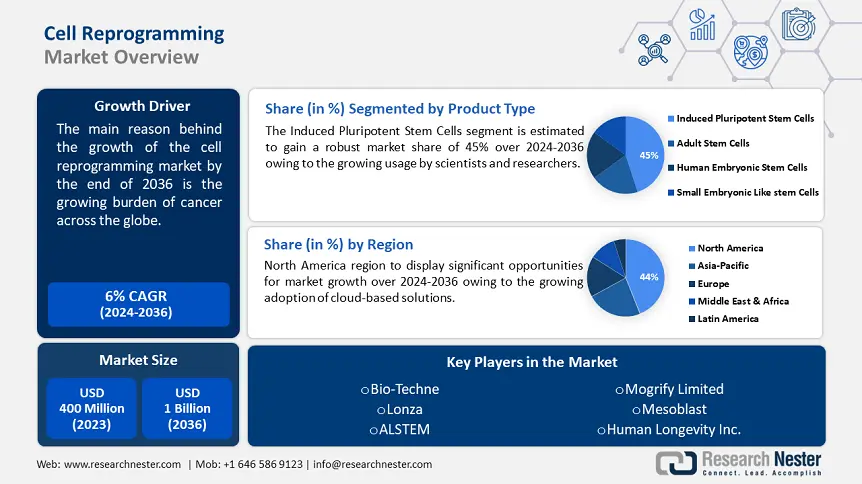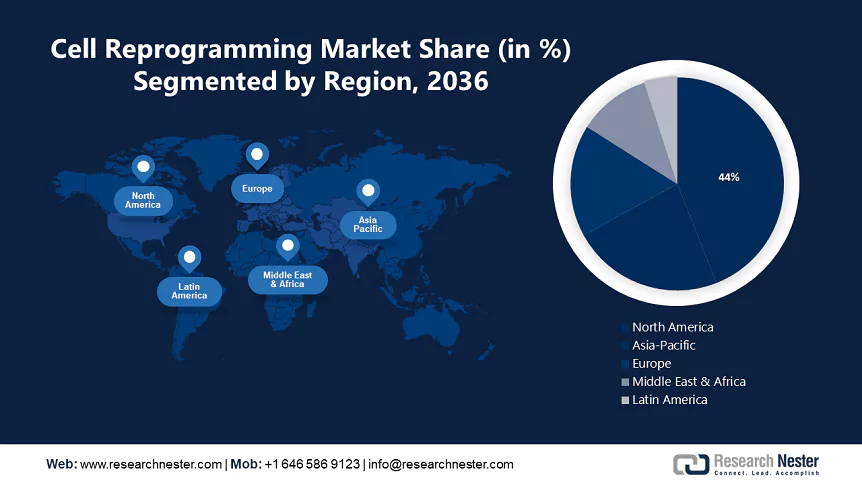
Cell Reprogramming Market size is poised to reach USD 1 Billion by the end of 2036, growing at a CAGR of 6% during the forecast period, i.e., 2024-2036. In the year 2023, the industry size of cell reprogramming was USD 400 Million. The reason behind the growth is the rising burden of cancer across the globe. Developing nations may bear a disproportionate share of the cost of cancer incidence, morbidity, and mortality owing to rising levels of air pollution, unhealthy diets, drinking alcohol, smoking, and not moving around much. According to the World Health Organization (WHO), it is anticipated that there will be over 35 million new cases of cancer in 2050, a 77% increase over the projected 20 million cases in 2022.
The growing advancements in technology are believed to fuel market growth. For instance, researchers have reported using a cell reprogramming technique to create neural networks that mimic distinct features of human cells, which could facilitate the development of new treatments for neuropathies.

Growth Drivers
Challenges
|
Base Year |
2023 |
|
Forecast Year |
2024-2036 |
|
CAGR |
6% |
|
Base Year Market Size (2023) |
USD 400 Million |
|
Forecast Year Market Size (2036) |
USD 1 Billion |
|
Regional Scope |
|
Product Type (Induced Pluripotent Stem Cells, Adult Stem Cells, Human Embryonic Stem Cells, Small Embryonic Like Stem Cells)
The induced pluripotent stem cell segment in the cell reprogramming market is estimated to gain a robust revenue share of 45% in the coming years, owing to the growing usage by scientists and researchers. Induced pluripotent stem cells are used by modern scientists and researchers to investigate human development and have been applied to numerous scientific investigations and clinical trials, such as those involving disease modeling, regenerative medicine, drug cytotoxicity, and discovery studies.
Also, the development of iPSCs has revolutionized stem cell research and created exciting new opportunities for improving cancer treatment, understanding tumor progression, and cell treatment. Moreover, there is a lot of optimism for the therapeutic use of induced pluripotent stem cells (iPSCs) in several disorders, as researchers may now address disease characteristics and how they progress in a cell culture plate by using pathogenic cells produced from patient cells.
End-Users (Hospitals, Research Organizations, Toxicity Test)
The research organization segment in the cell reprogramming market is set to garner a notable share in coming years. For scientists doing stem cell research, superior cell reprogramming techniques were created, a fascinating field of biomedical engineering study involving the direct conversion of an adult cell from one type to another. For instance, more information regarding naïve stem cell reprogramming has been made available to researchers from the Babraham Institute's Epigenetics research group that outlines the crucial regulators of reprogramming for a more effective method of producing human naïve pluripotent stem cells.
Our in-depth analysis of the global cell reprogramming market includes the following segments:
|
Product Type |
|
|
End-Users |
|
|
Derived Cell Types |
|
|
Application |
|
|
Reprogramming Type |
|
North American Market Forecast
The cell reprogramming market in North America is predicted to account for the largest share of 44% by 2036, propelled by the growing adoption of cloud-based solutions. Cloud computing is becoming increasingly popular in the United States since it greatly improves communication between patients, providers, and stakeholders in the healthcare industry. For instance, by 2026, more than 65% of all hospitals and health systems in the US will probably have implemented a cloud-based supply chain management strategy, which will aid in improving decision-making, increasing agility and efficiency, and streamlining procedures. This may drive the demand for cell reprogramming as researchers extensively rely on cloud platforms to support their studies.
APAC Market Statistics
The Asia Pacific cell reprogramming market is estimated to be the second largest during the forecast timeframe, led by the growing advancements in biomedical research. Moreover, the substantial investments made by the Indian government in biomedical engineering research and development are opening up more opportunities for biomedical research, which is currently being redefined by groundbreaking developments in gene- and cell-based treatment.
In addition, the Indian government has expressed interest in advancing stem cells and regenerative medicine, though the area of regenerative medicine is still in its infancy. However, there have been various encouraging advancements and interest in innovation and entrepreneurship.



Author Credits: Radhika Gupta, Shivam Bhutani
Copyright © 2024 Research Nester. All Rights Reserved

FREE Sample Copy includes market overview, growth trends, statistical charts & tables, forecast estimates, and much more.
Have questions before ordering this report?